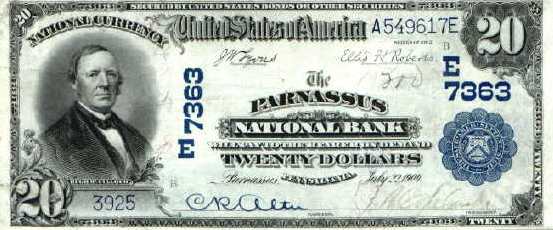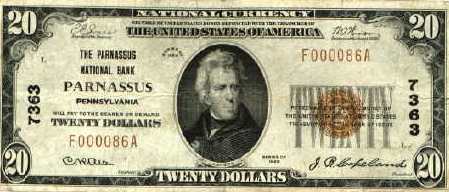THE PARNASSUS BANK
The history of the Parnassus Bank and old Parnassus, now a part of the city of New Kensington, began in the same year of 1872, when the bank was established and the borough of Parnassus was incorporated.
However, the name "Parnassus" was used as early as 1769 for the three hundred acre tract of land. Fort Crawford was built near the mouth of Puckety Creek and was used as a haven of refuge from hostile Indians by the few settlers here in the Allegheny Valley.
Parnassus was a pleasant and quite place in which to live. Its educational facilities were of the best. Religiously and socially, old Parnassus was the equal of any borough in the state.
The second burgess of old Parnassus became the first bank President of the Parnassus Bank in 1872 and was one of its founders. He was Dr. David Alter, who served as an army surgeon during the Civil War and afterwards was a highly successful physician with a practice in he Allegheny Valley. For many years, he was a railroad surgeon for the Allegheny Valley Railroad, between Pittsburgh and Oil City, which later became a part of he Pennsylvania system.
 Large $20 Note
Large $20 NoteDr. David Alter’s son, Dr. Joseph G. Alter, likewise had a long and honored career as a local physician and later as an ophthalmologist.
The Parnassus Bank opened for business in 1872 in a two-story frame building located on Main Street. A few years later, the bank moved into a newly constructed stone structure at the corner of Main and Fourth Streets, next door to the original bank building.
 Parnassus Bank Building
Parnassus Bank BuildingThe first cashier of the Parnassus Bank was Mr. Archibald B. Copeland, a prosperous and respected merchant of Parnassus. The store which he owned and managed so successfully was across the street from the Parnassus National Bank. He and his wife, Mary M. Copeland lived on Freeport Street.
During the early years, under able leadership, the bank weathered successfully the financial storms of 1873 and 1893 and increased in influence and prosperity.
When he was a boy, Charles R. Alter, who was later the President of the Parnassus National Bank, was the only milkman in Parnassus. He ran a milk-wagon for his father, before New Kensington was built.
and after that town was incorporated as a Borough in 1891. "Charlie, as he was known, was New Kensington’s first milk-man. While peddling milk, he had been asked to take his musical instruments and go on the road with Mr. Robert Klingensmith, who owned an Edison Phonograph, which was an usual means of entertainment in those days. Fortunately for his customers and the banking business, Charlie could not be spared from his milk route.
In 1895, Charlie entered he bank as a clerk, at the munificent salary of $15 a month. At this time, Mr. Alexander W. Logan was President and Mr. J. R. Alter, a cousin of C. R. Alter, was Cashier. Five years later, C. R Alter became Cashier of the bank, the youngest Cashier of his day.
David S. Gailey was president of the bank from 1904 to 1915. He was followed by J. R. Copeland who served as president until 1931 when C. R. Alter assumed that responsibility.
In August 1904, the Parnassus Bank received a national charter (No. 7363) and the name was changed to the First National Bank of Parnassus. As with other national banks, it too was allowed to issue United States currency displaying the charter number and the name of the bank on each note. The bank issued three types of large size currency during the third charter period and small size currency after 1929. The large size notes have the signatures of either D. E. Gailey (President) and C. R. Alter (Cashier) or J. R. Copeland (President) and C. R. Alter (Cashier). All small size notes were signed by J. R. Copeland and C. R. Alter. Both the large and small size notes were printed in denominations of $10 and $20, all of which are scarce today.
During the First World War, the Parnassus National Bank worked with untiring patriotism and was commended by the United States Treasury for its loyal support of the government in Liberty Loans of that period.
 Small $20 Note
Small $20 NoteIn May of 1930, the towns of Parnassus and New Kensington were consolidated under the name of New Kensington. On January 28, 1932, the name of the bank was then changed to the First National Bank of Parnassus, New Kensington.
On March 18, 1931, C. R. Alter was elected President of the bank and E. H. Blackburn, Vice President and Cashier.
During the years that followed, the Parnassus National Bank, New Kensington not only came through a major depression success-fully, but through the Second World War, which brought with it, as the worst war in history, many difficult problems.
In 1942, the bank observed the 70th anniversary of its founding, but during the war, there was no celebration. A notice to that effect was posted in the bank.
Bank customers enjoyed the friendly and courteous atmosphere as well as the bank’s display of antiques, included a 13 star flag that was once owned by Mr. John Agey, who lived on Bridge Street in Parnassus.
Citizens were shocked in 1951 when the local newspapers reported that the president of the First National Bank of Parnassus had been arrested for embezzling large sums of money. The bank was closed shortly after the news broke, and in 1953 the president was tried on embezzlement charges, found guilty, and received a ten year sentence. Thus the oldest and once prosperous bank of Parnassus came to a tragic end.